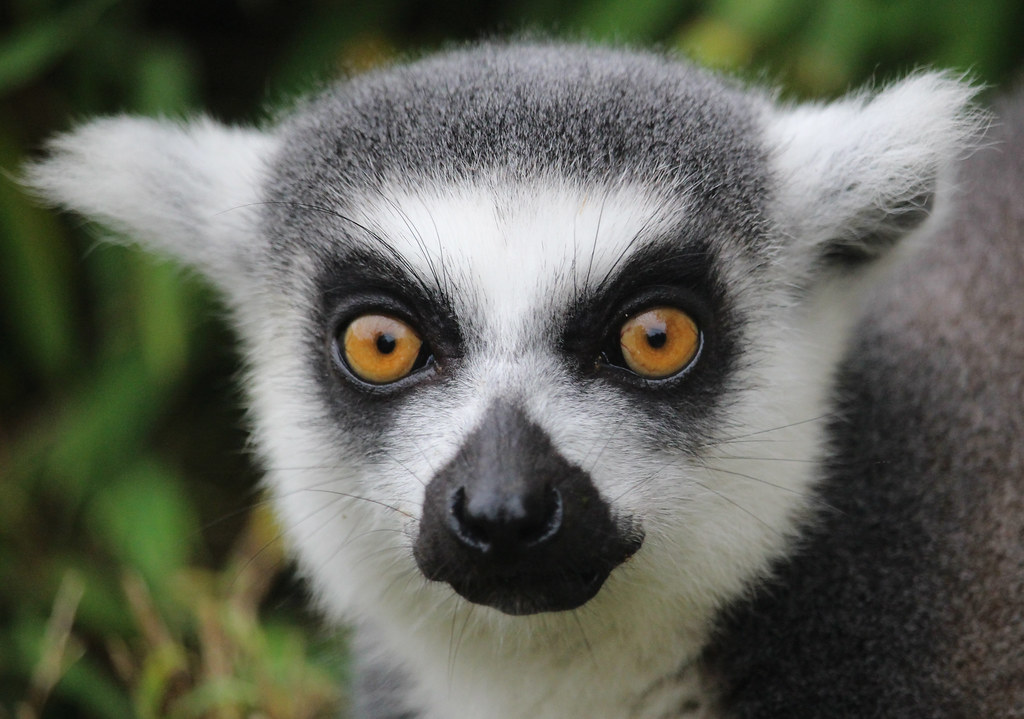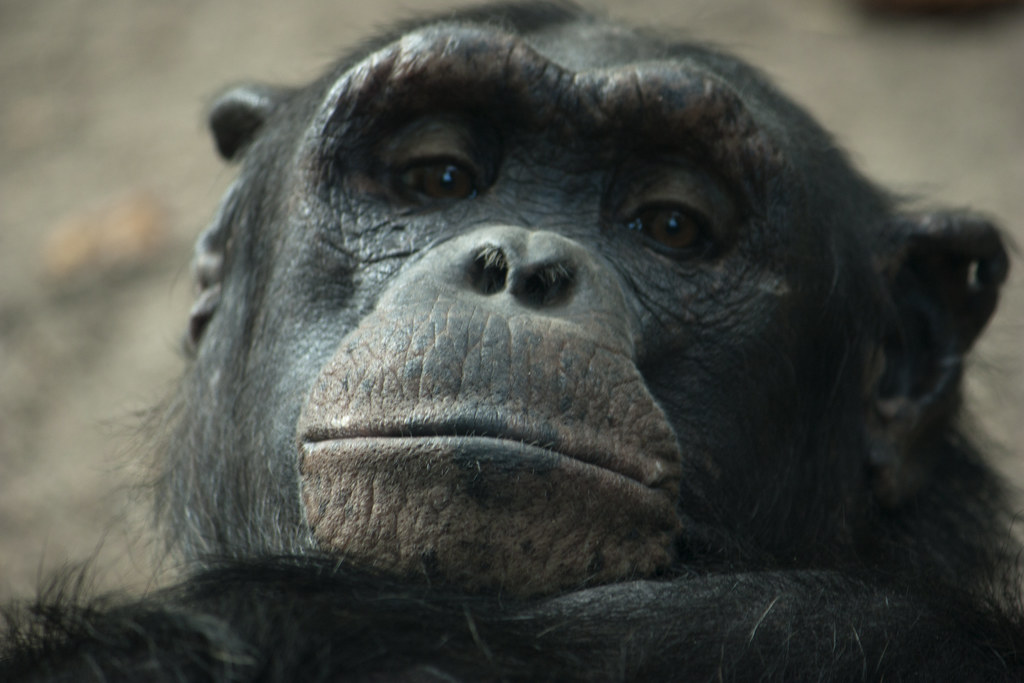4.2 The Primate Order
Some of the characteristics of primates (monkeys and apes) are thumbs and big toes that are opposable to some degree, flattened fingernails instead of claws, sensitive finger pads, prehensile tails (but not in all species), dentition suited to an omnivorous diet, and stereoscopic vision. These features are partly because primates are arboreal. Individuals that were able to judge distances between themselves and branches more accurately had a competitive edge over other individuals, which led to the development in primates of stereoscopic vision. Stereoscopic vision evolved convergently in carnivores that judge distances to capture fast-moving prey. Many early primates ate insects, and the visual predation hypothesis says that primate features evolved to help catch these insects in trees. However, today, many primates no longer eat insects.
Characteristics of Primates: Forward-facing eyes; eyes protected by bone; nails instead of claws (claws are part of the skeleton while nails grow on top of a nail bed over the skin); larger brain; longer periods of maternal investment of offspring and giving birth to fewer offspring at a time. 250 or so species of primate exist today; most taxonomists group them into 13 families. All share a lengthy list of defining features, mostly related to the following broad categories:
- Limbs and locomotion. The hands (and often the feet) are grasping, with mobile fingers and toes, generally with touch-sensitive pads at the tips. The first digit (the thumb or the hallux, i.e. big toe) is normally divergent (i.e. points outwards) and in many species can be swiveled to bring its tip into contact with other digits; in other words, it is opposable, to a greater or lesser degree. (Try this with your own hand to verify it.) Rather than a curved and rigid claw, at least some of the digits of primates have flat nails, making manipulation (e.g. of food) practicable. They have very flexible shoulder joints; hind-limbs are normally dominant in locomotion.
- The senses. The eyes point forwards and are set close together. The fields of view of the eyes overlap which, together with a distinctive ‘wiring’ arrangement linking the eyes and the brain, imparts stereoscopic, ‘3-D’ vision. In general, vision (like hearing) is more significant than smell, and color vision is widespread. The face is flattened, with the muzzle (i.e. the area of skin around the nostrils) foreshortened; this anatomical change may, in part, be a reflection of the diminished importance of smell.
- The brain. This organ is relatively large. The cerebral cortex – in primates, more often called the neocortex – is elaborately folded and complex in structure. This part of the brain is involved with the highly complex processes that include learning, reasoning, and memory.
Prosimian/Strepsirrhines
Ancestral primates are called Strepsirrhines. Not much changed since the original ancestor. Traditionally these primates were called Prosimians and the monkeys and apes were called Anthropoid. Classification was mainly based on physical features. However, genetic analysis of a small primate in Indonesia, the Tarsier, showed that it had features of both groups (along with unique features not shared with any other primate), but that its DNA was more like the Anthropoids. The Tarsier was moved into the Anthropoid group and scientists renamed the groups Strepsirrhine (primitive) and Haplorhine (monkeys and apes). Examples of Prosimian/Strepsirrhines: lemurs in Madagascar, lorises and galagos in Asia, and bush babies in Africa.
Unique features of Prosimian/Strepsirrhines: grooming claw (retention of one claw alongside nine nails); tooth or dental comb (lower set of incisors stick forward and are used for grooming); post-orbital bar (semi-protection of the eye with bone). Some Prosimian/Strepsirrhines still use smell more than monkeys and apes and some are nocturnal.

Anthropoid/Haplorrhines
Anthropoid/Haplorrhines have evolved features that have given them a competitive edge over other animals, especially other primates. They are diurnal rather than nocturnal, they form year-round male-female relationships and live in social groups (a trait that evolved later and independently in lemurs), and they communicate extensively through gestures and vocalization. A diurnal pattern of activity means that, like us, nearly all anthropoid primates are awake during the day and asleep at night. Prosimian/Strepsirrhines have adaptations for nocturnal living, such as large eyes, sensitive night vision with a resultant loss of color vision, and a well-developed sense of smell. Many also have large ears that can move independently of each other. In contrast to prosimians, the diurnally living anthropoids have evolved superior stereoscopic and color vision with an associated reduction in the structures and brain processes related to smell. This helps anthropoids find fruit that is ripe and ready to eat. As stereoscopic color vision developed, the sense of smell became less important.
The suborder Anthropoidea includes monkeys, apes and humans. Taxonomists group monkeys according to the shape of their nose: Old World monkeys (found in Africa and Asia) are Catarrhines and New World monkeys (found in the Americas) are Platyrrhines. In fact, apes and humans originated in the Old World, so they too belong to the Catarrhines, whereas the New World monkeys are sufficiently distinct to be contained within a grouping of their own.
The marmosets, tamarins and capuchin-like monkeys of the New World are found in Central and South America; they comprise two related families in Platyrrhine. Old World monkeys, such as baboons, mandrills, mangabeys, guenons, macaques, colobus, and langurs, are found in Africa and Asia; they belong to a single family in Catarrhine called Cercopithecoidea. Apes (gibbons, orangutans, gorillas, chimpanzees and bonobos) and humans comprise the Catarrhine category of Hominidae.
It’s important to note that the terms Old World and New World are themselves, outdated. An increasing number of anthropologists acknowledge the colonial bias present in these choices. In response, the terms South American, African, and Asian are beginning to replace Old World and New World.

(chiefly of animals) living in trees.
the ability of the visual brain to register a sense of three-dimensional shape and form from visual inputs.
coming closer together, especially in characteristics or ideas; in evolution, two species sharing a trait from different evolutionary trajectories.
being awake during the day; most activity occurs during the day.
being awake at night; bulk of activity occurring in the dark or around dusk/dawn.
a movement of part of the body, especially a hand or the head, to express an idea or meaning.
the act or process of producing sounds with the voice, lungs, throat, or mouth.

